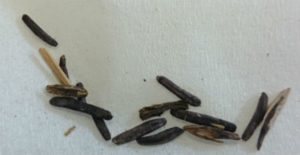Ergotism – What Does It Cause?
19 December 2016 There are 3 main forms and disease is reported more often in cattle than in sheep:
There are 3 main forms and disease is reported more often in cattle than in sheep:
Chronic
- This is the most common form.
- Contaminated grain is fed over a long period of time.
- After 2 to 6 weeks the animals may become lame/recumbent.
- Diarrhoea may be seen.
- The toxins restrict blood flow to the extremities; lower legs, tail and ears, which become gangrenous and die.
- Affected areas become red and swollen and feels cold to touch with loss of sensation. Hair is lost and an indented line appears at the junction between normal and dying tissue. This is not painful.
- Affected tissues become blue/black. They start to separate from normal tissue and will eventually drop off.
Acute
- Animals may appear drowsy and can stagger or fall.
- They may become temporarily blind/deaf.
- They have episodes of fitting during which they may die.
Hyperthermic
- Affected animals have high temperatures.
- They may breathe heavily/quickly and salivate.
- Milk production and growth rates are reduced.
Long term, low level feeding can reduce feed intakes and live weight gains. Winter coats may not be shed. In sheep ulceration of the tongue, mouth, stomachs and intestines has been reported instead of limb gangrene.
There is no treatment for ergotism.
Heather Stevenson, heather.stevenson@sac.co.uk
Sign up to the FAS newsletter
Receive updates on news, events and publications from Scotland’s Farm Advisory Service
